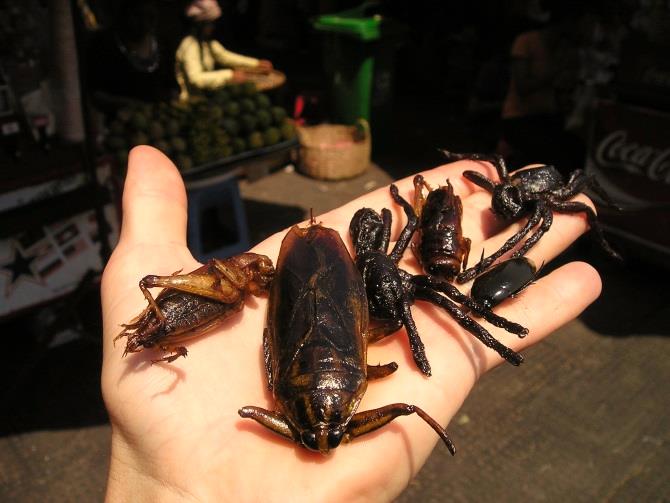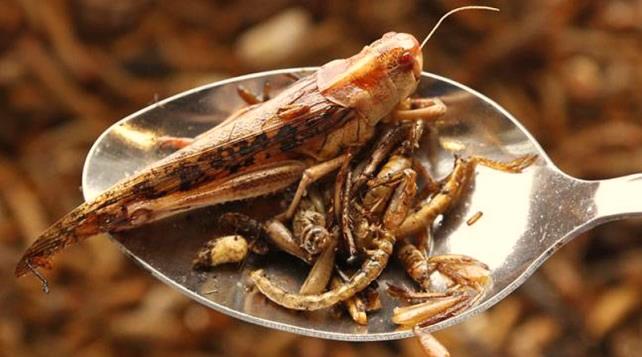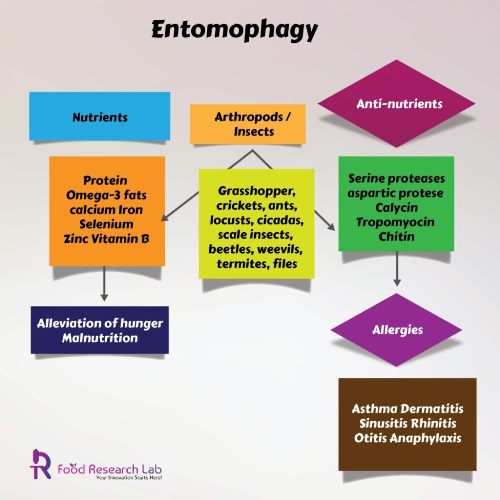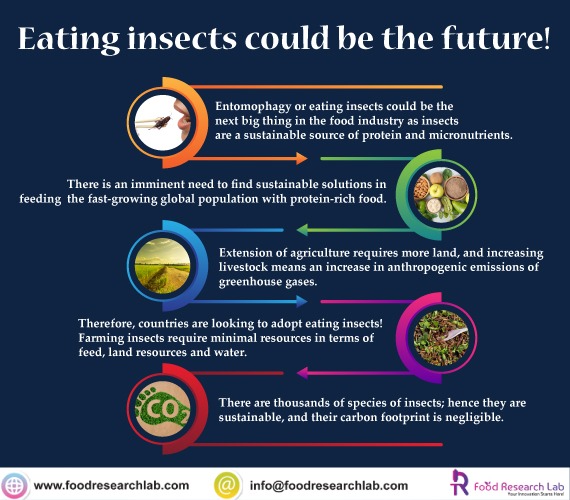Animal-based products, such as meat and milk, deliver primary nutritional components around the globe. To handle the rapidly growing population and to sustain global food production by keeping an account of the carbon emissions during this process is proving to be quite challenging. One of the potential alternative sources of proteins is edible insects with protein content ranged from 35% to 61%, lipids (13-33%) and contains significant amount of animal fiber in form of insoluble chitin[1]. Insects are a part of the human diet in many cultures in different countries. However, entomophagy is not promoted widely even by many international organizations. The common popular insects fall into these categories, beetles, bees, caterpillars, ants, wasps, locusts, crickets, leafhoppers and grasshoppers, true bugs, termites, dragonflies and flies. Edible insects have a great potential to become a major source of human/animal nutrition to produce efficient and sustainable energy sources. Insects do not use their metabolism to raise or drop the temperature to reduce energy usage. Insects also have high prolificacy compared to conventional livestock. The overall efficiency is also improved by the rapid growth rate and achieves maturity in days rather than months.
Challenges in Formulation of Edible Insects
Animal-based products, such as meat and milk, deliver primary nutritional components around the globe. To handle the rapidly growing population and to sustain global food production by keeping an account of the carbon emissions during this process is proving to be quite challenging. One of the potential alternative sources of proteins is edible insects with protein content ranged from 35% to 61%, lipids (13-33%) and contains significant amount of animal fiber in form of insoluble chitin[1]. Insects are a part of the human diet in many cultures in different countries. However, entomophagy is not promoted widely even by many international organizations. The common popular insects fall into these categories, beetles, bees, caterpillars, ants, wasps, locusts, crickets, leafhoppers and grasshoppers, true bugs, termites, dragonflies and flies. Edible insects have a great potential to become a major source of human/animal nutrition to produce efficient and sustainable energy sources. Insects do not use their metabolism to raise or drop the temperature to reduce energy usage. Insects also have high prolificacy compared to conventional livestock. The overall efficiency is also improved by the rapid growth rate and achieves maturity in days rather than months.


If we closely look at the macronutrients, levels of protein, fat and energy vary based on what the insects have consumed, their stage of development, sex and environmental factors. Edible insects are high in protein components ranges 30 % to 65% of the total dry matter, with energy content (400-500 kCal per 100g dry matter) exceeding the fresh meat sources. The unsaturated fatty acid profile is very similar to that of poultry. Eicosapentaenoic acid (EPA), omega 3 fatty acids and docosahexaenoic acid (DHA) were found to be the primary types enhancing cellular function supplied from the diet. The overall fat content is ranging between 7 to 77g/100g of dry weight depending on the larvae. In terms of micronutrients, the amount of iron is between 18-1562 mg/100g dry matter, with the lowest amount in ants, average quantities found in termites and the highest levels identified in crickets. Moreover, crickets have also been reported to contain zinc between 8-25mg/100 g dry matter. Ants, termites and crickets contain calcium in the range of 33-341 mg/100g of dry matter. Across different insect species, vitamin A was found to be from 3-273 μg/100 g dry matter.
Potential of black soldier fly larvae fat (BSF LF) as butter substitute for bakery products were examined by Delicato in the recent Journal of Food Quality and Preference (2020[1]). The findings showed that BSF LF replace 25% of butter in bakery products without changing acceptance. In Waffles, the substitution can even go up to 50%. In fact Willingness to Pay (WTP) for the cookies prepared with R.differens (95%) was higher than olive oil.
Insects can also be used as a replacement for fish meals and oil in animal diets. The global feed production in 2011 was evaluated at 870 million tons worth US$ 350 billion. Meal and oil from fish and soybean have been used for aqua and animal feed. BSF (common housefly, yellow mealworm) larvae mature quickly and contain 42% protein and 35% fat which would make a suitable food for livestock and fish. Housefly maggots are already being used as poultry feed in tropical countries. Dehydrated larvae of flies are comparable to soybean meal, which is aka to protein supplement for turkey. The mass production technology of fly larvae needs to be further developed and investigated. The grasshopper could be a meal replacer for chicken and rabbit diets containing soybean and fish meal.
How to farm these insects on a mass scale?
Insects like honey bees and silkworms have been domesticated for a long time for their byproducts. Cochineal insects yield carminic acid, which is used as a red dye as a food colouring, as well as in pharma and cosmetic industries. In countries like Peru and Mexico, cochineals are harvested from pear plants and also from environmental controlled plastic micro tunnels. One of the options available is to harvest the edible eggs of aquatic hemipterans to the artificial oviposition sites. Alternatively, we can deliberately cut palm and pear trees to trigger egg laying and subsequent larvae harvesting.
In Thailand, commercial farming of cricket, giant water bug and palm weevil is done successfully. Moreover, Chinese farm water beetles. Industries find it challenging to mass rearing insects for human or animal consumptions due to quality, cost-effectiveness and reliability.

Sensory & Organoleptic properties
Aroma and acidity: Ants are aromatically diverse due to their range of pheromones which is used to communicate with others. Ants have a powerful sour taste due to the presence of formic acid. The common wood ant found in the Danish forests has a lemony taste with a burnt sugar taste. The smelling carpenter ants in Denmark have a gentler acidity which is a pronounced aroma. Due to their great taste and small size, this species could use it in the context of spices and seasonings.
Umami: Finding sources of natural umami taste with versatile savouriness is of great interest. Grasshopper locusts are optimal for eating whole and feed on grass without pesticides or fertilizers. These locusts are purged for 24 hrs., frozen and blanched for 5 minutes and stored at 5°C.
Texture: Insects contain crunchy exoskeleton with chitinous are either removed or broken down during cooking. Insects in their larvae stage have many delicate textures, for instance, bee larvae. Larvae contain about 50% protein and 20% unsaturated fats providing gentle soft savoury and fatty notes, similar to hazelnuts, flowers, avocado and herbs.
Consumer acceptance
Humans are inclined to avoid unfamiliar food; however, with novel foods, humans exhibit a curious interest as well as reluctance to the opportunity that insects may be toxic. Early disgust prevails with a few foods, and some food preferences are not stable, which can change over time. Consumer acceptance of insects and insects-based food ingredients is a significant area that gets broad public debate to arrive at sustainable food production. Suitable processing strategies and development can be implements to transform insects or insects protein into conventional forms of foods, such as hot dogs or fish fingers.

Conclusion
As a consumer, we should be aware of entomophagy, and the insect rearing might become a necessity in the future. Some consumers in different countries are willing to pay a premium price as street foods are sold in hygienic conditions. Entomophagy is revalidated from time to time with the help of worldwide campaigns in countries suffering from acute food shortages. The global strategy is to maintain sustainable food security for everyone.
Food Research Lab can help you solve these problems related to the formulation of food products with edible insects. FRL is for food and nutraceutical manufacturers as well as those companies involved in NPD and developing spec without manufacturing. FRL gives you the ability to improve all phases and aspects of new product development, such as original specification, ideation, shelf-life, packaging. Additionally, you can get them out to market quicker than ever before.

Let’s create something Innovative and Delicious together
Food Research Lab strives for excellence in new Food, Beverage and Nutraceutical Product Research and Development by offering cutting edge scientific analysis and expertise.




